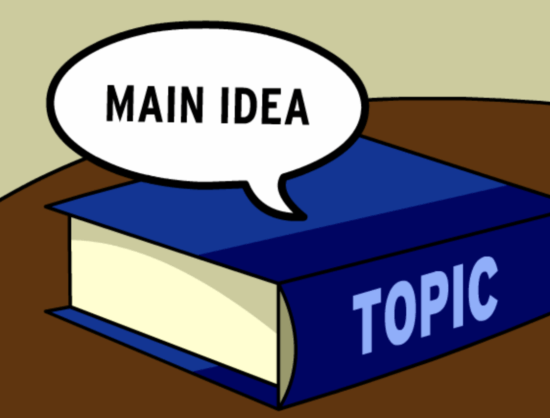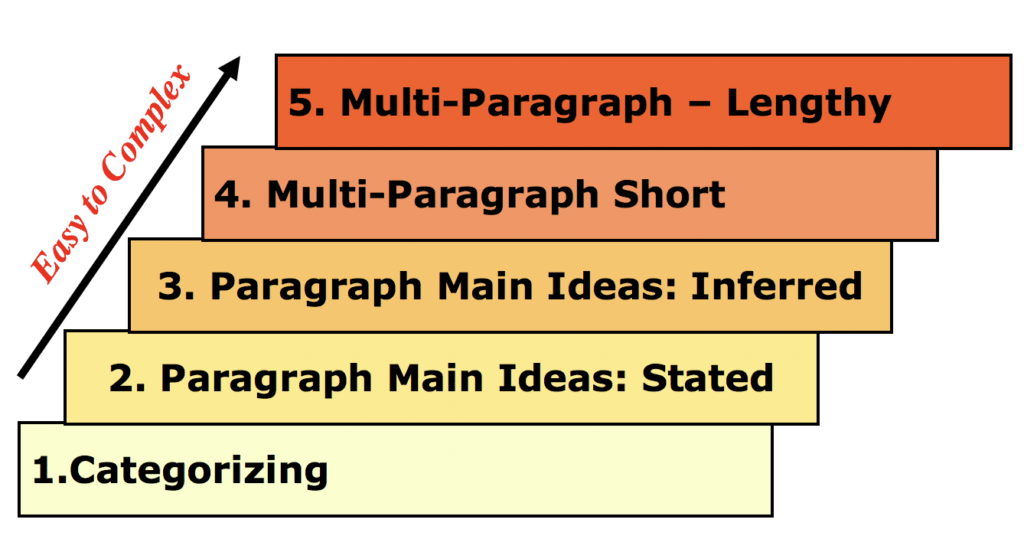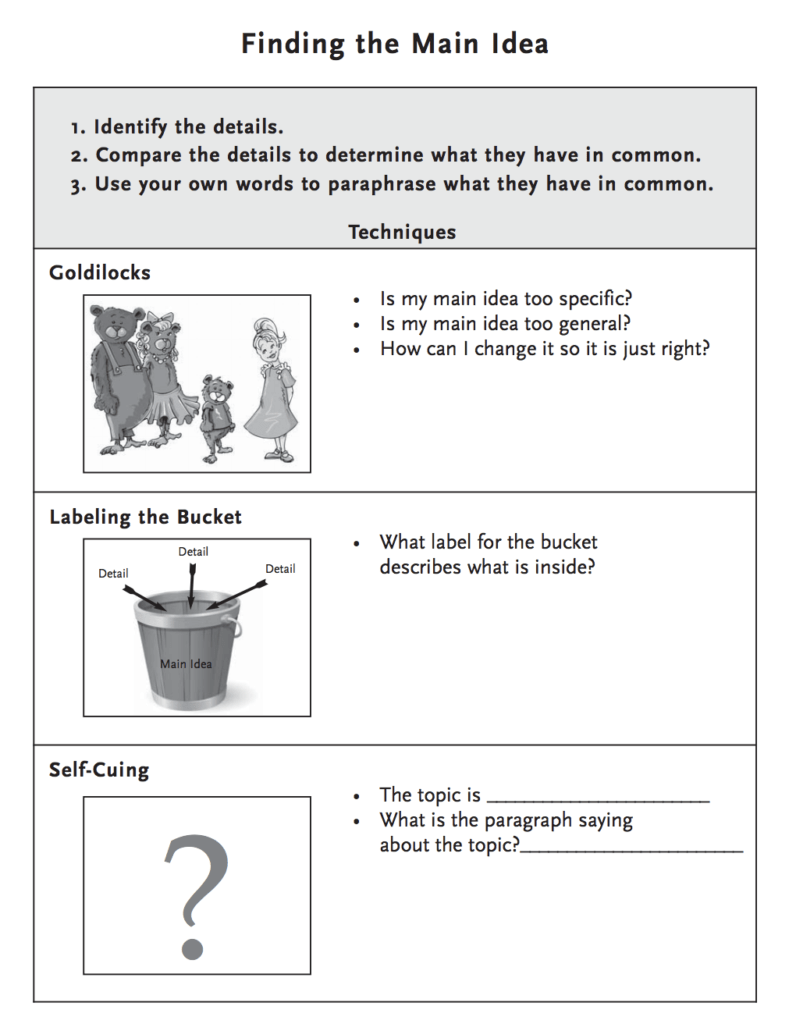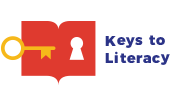How to Teach Main Idea

The ability to identify and state main ideas and distinguish them from supporting details is a foundational comprehension skill. Instructional practices for this skill are an integral part of several Keys to Literacy professional development programs, including The Key Comprehension Routine and Keys to Content Writing. Its importance as a reading skill is highlighted as one of the 10 anchor standards in the Common Core ELA standards:
Reading Standard #2: Determine the central idea or themes of a text and analyze their development; summarize the key supporting ideas and details.
While main idea skills are often associated with comprehension of text, we emphasize that these skills can be applied to anything that is read, said, or done in the classroom. We also believe that students need explicit instruction for teaching main idea skills.
Terminology
Different words and phrases are used to refer to main idea skills, including: chunking, grouping, categorizing, getting the gist, identifying the topic, identifying the central or main idea, theme, topic sentence, seeing the forest through the trees.
In a fall, 2018 blog post, Tim Shanahan writes about main idea skills and notes the discrepancy in terminology. “Not everyone even agrees on what label to use. Are we talking about main ideas, central idea, purposes, topics, central messages, or themes?” He also points out that teaching main idea is complicated. The trainers at Keys to Literacy agree!
We suggest a scope and sequence for teaching main idea that begins with simple categorizing to identifying multiple main ideas in lengthy text, as illustrated below.

Instruction for main ideas can begin in kindergarten and grade 1 with an emphasis on categorizing objects, pictures or words. Categorizing practice continues in later grades by having students categorizing content vocabulary terms, which is also a highly effective strategy for learning new words (see The Key Vocabulary Routine).
As students develop the skills to read paragraphs and multi-paragraphs, they can be taught how to identify and state paragraph main ideas. This task is more difficult when reading paragraphs that have implied main ideas. And as students move into higher grades, the skill extends to identifying central main ideas for larger chunks of text.
The Key Comprehension Routine uses three techniques for
helping students identify main ideas:
- Self-Cuing: Self cuing prompts students to ask themselves questions in order to identify the big idea of a source, which may be anything that is read, said, or done. The student asks these questions: Who or what is the focus of the source? What is most important about it?
- Goldilocks: Sometimes the main idea that students give is too general or too specific. This technique has students analyze their response to determine if it is too general, too specific, or just right.
- Label the Bucket: This technique uses a metaphor. Students are asked to think about stating a main idea as if it were a label on a bucket to describe what is in the bucket.
Click here for a handout with the three techniques that looks like the visual below.

If you would like to learn more about teaching main idea skills, consider purchasing our Key Comprehension Routine books (Grades K-3, or Grades 4-12).
Also, here are a few instructional suggestions from Shanahan’s
blog post mentioned above, all of which are aligned with Keys to Literacy
instructional practices:
- Teach it as part of a larger and more coherent reading strategy.
- Teach kids to summarize paragraphs first.
- When kids are successful with shorter texts, teach them to try the same thing with longer texts.
- Vary texts in terms of topics, difficulties, lengths, inclusion of seductive information, explicitness of main ideas.
- Use a “gradual release of responsibility “approach.

 Joan Sedita is the founder of Keys to Literacy and author of the Keys to Literacy professional development programs. She is an experienced educator, nationally recognized speaker and teacher trainer. She has worked for over 35 years in the literacy education field and has presented to thousands of teachers and related professionals at schools, colleges, clinics, and professional conferences.
Joan Sedita is the founder of Keys to Literacy and author of the Keys to Literacy professional development programs. She is an experienced educator, nationally recognized speaker and teacher trainer. She has worked for over 35 years in the literacy education field and has presented to thousands of teachers and related professionals at schools, colleges, clinics, and professional conferences.
Hi Joan,
This tool looks very useful, but I am confused as I have read online that it’s a waste of time to teach students to find the main idea and that the reason for this is that it is not a reading skill as it is not repeatable and also because finding the main idea is a test of content knowledge and therefore students who know more about a topic in question are going to do a better job at it.
Is this right?
When my students are taking MAP tests, I see questions asking them to state the main idea of a passage, but I never thought this was a test of content knowledge. Sure, background knowledge is an affordance here but they still have to engage with the text to figure out the main idea.
Also, finding the main idea is very prominent in the common core standards so I assumed it was an important thing that readers do.
Many thanks,
Mat
First of all, what you read online isn’t always supported by research! The author of a recent and popular book that promotes the importance of background knowledge as it relates to reading comprehension has made the assertion that it is not worth teaching main idea and other comprehension skills/strategies because 1) students only need a few weeks instruction one time to learn them, and 2) what teachers should spend time on is developing students’ wide background knowledge. While it is true that the more someone knows about a topic they are reading the easier it will be to comprehend that text, on the flip side there is no strong research showing that if students in general grow their overall knowledge that this results in overall improved comprehension. However there is decades of research showing that explicit strategy instruction does improve comprehension. One of the most researched strategy is teaching summarizing. And what’s at the core of being able to write a summary? Main idea skills! I agree that worksheets that give single paragraphs and ask students to underline the main idea are not that helpful, but teaching students how to infer the main idea in text and write it in their own words that incorporates critical thinking does work. Students also need to be able to discern the difference between main ideas and detail to take notes and write good paragraphs. And as you point out, identifying the central and main ideas in text is a big part of state standards. So, don’t give up on teaching main idea skills!
Thank you for such a clear response Joan.
I must admit to being confused by the paradox of background knowledge and comprehension ie. why research does not show that increased knowledge leads to increased overall comprehension especially when readers who know more about a topic can find a text easier to comprehend. Doesn’t the common core recommend a knowledge rich curriculum and a big increase in the amount of non-fiction reading?
On the topic of main ideas, I wonder why programs like Writing Revolution teach very specifically to start all informational paragraphs with a topic sentence, when in reality some paragraphs might have a topic sentence in a different location or even none at all as it needs to be inferred!
Another good question, Mat! In an explicit, systematic approach to teaching any component of literacy, the teacher introduces a skill by giving examples of the most basic level of that skill. After the basics, the teacher then moves through a sequence that introduces more complex application. In the case of instruction for writing paragraphs, the most level is teaching students to state the main idea of a paragraph they are writing in the first, topic sentence. However, as students learn more sophisticated levels of paragraph structure, they can then be taught that the main idea might be found anywhere in the paragraph. And in fact, it might not be stated at all, leaving it up to the reader to infer the main idea based on the details provided.
Many thanks for that excellent clarification Joan on writing with main ideas.
Lastly on the subject of knowledge rich curriculums such as what the common core seems to be advocating, is it the case that we want a knowledge rich curriculum as it may create an affordance for comprehension, but we should not assume for any particular text that it will lead to strong comprehension as it also depends on how a reader is making sense of the text through other means such as inferring and use of reading strategies?
I think you’ve summed it up very nicely! It is impossible to make sure students have knowledge about everything and anything they might read about. So, while developing strong general knowledge about the world, we have to make sure that students have the skills and strategies to unpack what ever it is their reading.
I need some help in Main Ideas
I would also like some more ideas for teaching main idea in 2nd grade. I have done the typical Highlght main idea in green and supporting details in blue. I have found that this does not allow students to think critically, but rather searching for information. I also find that scaffolding is a great way to teach Main Idea with a one or two week period. I usually start with a picture and have students identify the main idea by choosing a phrase that describes what is happening in the picture.
This is a very important skill to be able to teach well to students. Like the material indicates, it can be difficult, especially when it has to implied. This can prevent a serious challenge to students. Especially, in teach8iing students with special learning needs, this is critical.